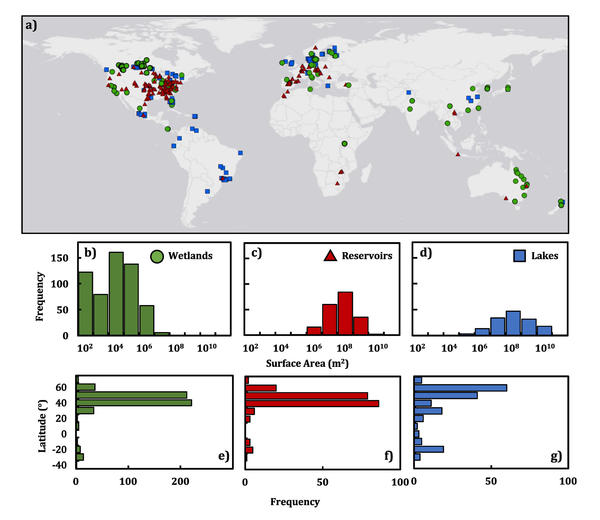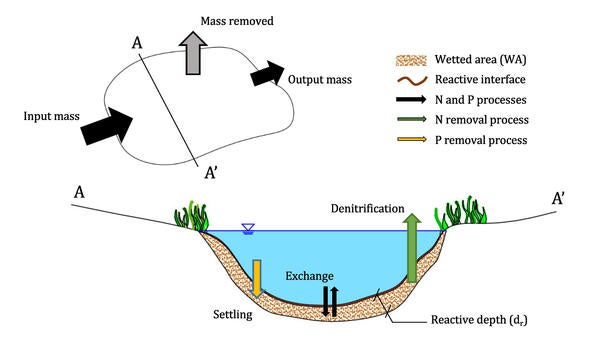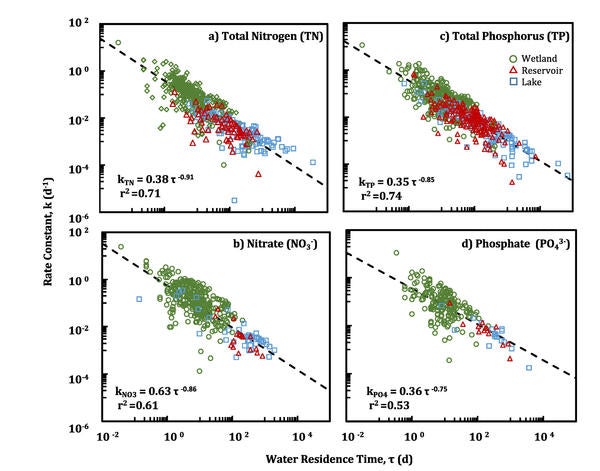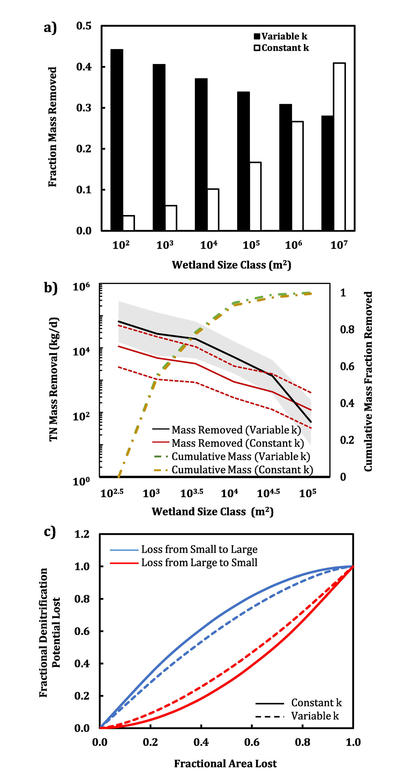 Excess nutrient pollution from agriculture and urban intensification poses an increasing threat to water quality worldwide. Wetlands, lakes, and reservoirs restrict the movement of nutrients such as nitrogen and phosphorus and thus have the ability to protect downstream waters. Despite the large role wetlands play as wetlands nutrient sinks, they have received the least attention in most global-scale studies of nutrient retention. Similarly, while the greater role of smaller systems in global nutrient processing has been recognized for lakes and reservoirs, there has been relatively less research exploring the role of system size on nutrient processing for wetlands.
Excess nutrient pollution from agriculture and urban intensification poses an increasing threat to water quality worldwide. Wetlands, lakes, and reservoirs restrict the movement of nutrients such as nitrogen and phosphorus and thus have the ability to protect downstream waters. Despite the large role wetlands play as wetlands nutrient sinks, they have received the least attention in most global-scale studies of nutrient retention. Similarly, while the greater role of smaller systems in global nutrient processing has been recognized for lakes and reservoirs, there has been relatively less research exploring the role of system size on nutrient processing for wetlands.
This study addresses this knowledge gap by quantifying the role of small and large wetlands in nutrient processing within the broader context of nutrient removal processes in aquatic systems. Specifically, the study aimed to answer questions on the emergent patterns between nutrient processing rates and residence times in wetland, lake and reservoir systems; the underlying mechanisms contributing to the observed pattern; and, the relative magnitude of nutrient retention as a function of wetland size.
Methodology
A database of wetland, lake and reservoir systems and their nutrient processing capabilities was compiled through a literature review. Studies providing data on hydraulic residence times, as well as input-output concentrations and mass loads, were included in the database. A total of 1,604 data points representing approximately 600 sites were included in the analysis (Figure 1).

FIGURE 1: (a) Locations of the study sites and the size and latitudinal distribution of wetlands (b,e), reservoirs (c,f) and lakes (d,g) included in the analysis
Nutrient retention in wetlands, lakes, and reservoirs is generally estimated as the difference between input and output fluxes, while retention processes are typically modelled as first-order reactions. To draw on literature of different disciplines and systems of variable spatial scales in a comparable framework, we fitted the input-output loadings of wetlands, lakes and reservoirs into continuously stirred tank reactor and plug flow reactor models to determine the effective volumetric removal rate. The estimated rate constants were regressed against various system parameters (water residence time, depth, surface area) to understand dominant control variables. Additional relationships between surface area and parameters such as flow, mass loading, depth and residence time were tested based on the data set and subsequently used for modelling and upscaling.
We developed a two-compartment mechanistic model describing hydrologic and biogeochemical interactions between the water column and the sediment to explain the dominant controls on nutrient removal processes (Figure 2). The goal of the model was not to fully capture the complexity of flow and biogeochemistry, but to test the hypothesis that smaller water bodies have a greater sediment contact area to water volume ratio, and are thus more effective biogeochemical reactors than larger water bodies. In order to understand the relative contribution of small versus larger wetlands, we upscaled our analysis to the landscape scale, using the Des Moines Lobe in Iowa, USA as a sample site.

FIGURE 2: Plan and cross‐sectional view of the sediment‐water model for nutrient mass removal
Outcomes
The mean per cent nutrient removal value for wetlands, reservoirs and lakes showed no significant differences between systems and across constituents. However, the volumetric nutrient removal rate constants were found to have a strong significant inverse relationship with the residence time of the system (Figure 3). The similarities in the effective removal rates between a biologically mediated nutrient (nitrogen) and a physically-mediated nutrient (phosphorus) suggests the dominance of hydrologic controls on biogeochemical functioning. An inverse power law relationship between nutrient retention rate constant and water body size shows that smaller wetlands are more effective at nutrient retention than large wetlands. We therefore argue that the physical mechanism responsible for this inverse relationship is an increasing sediment area to water volume ratio with decreasing system size.

FIGURE 3: Removal rate constant (k) versus water residence time (τ) for Total Nitrogen and Total Phosphorus
The correspondence between the modelled and data-derived relationships confirmed our hypothesis that the greater surface area to volume ratio of the smaller water bodies is the primary factor contributing to their larger rate constants. The model demonstrated that we could reproduce the inverse relationship keeping biogeochemical factors the same, but only modifying the physical factor, the sediment area to volume ratio, thus proving that the system size controls the inverse behaviour. When we upscaled these results from individual wetlands to the wetlandscape in the Des Moines Lobe case study area, our results showed that when we lose an equal area for small wetlands versus large wetlands, loss of the smaller wetlands will lead to a greater fraction of the landscape nutrient removal potential being lost because of the higher reactivity of smaller wetlands (Figure 4). This is important because wetland restoration has traditionally focused more on larger wetlands, while small wetlands have been under the greatest threat from development.

FIGURE 4:(a) Per cent mass removal for different wetland size classes. (b) Total and cumulative nitrogen mass (TN mass) removed for the Des Moines Lobe site. (c) Fractional denitrification potential lost as a function of fractional wetland area lost.
Conclusions
Wetlands function as critical sinks of nutrients in the landscape, and thus significant research has focused on understanding the biogeochemical cycling of nutrients in wetlands over the last few decades. However, most studies have focused on individual wetlands, making it difficult to extend these findings to wetlandscapes, which are composed of a distribution of wetlands. This study explored nutrient retention potential across various wetland types and sizes and placed these results in the context of other still freshwater systems, namely lakes and reservoirs.
Based on a synthesis of data from wetlands, lakes, and reservoirs worldwide and sediment-water modelling, we found that smaller water bodies tend to have higher nutrient removal rates. The study, for the first time, quantifies the disproportionately larger role small wetlands can play in landscape nutrient processing. In many regions, wetland area losses are skewed toward smaller systems. These smaller wetlands provide critical watershed functions and play a disproportionately large role in landscape-scale nutrient processing. Future wetland protection and restoration eff orts, therefore, should value and focus more strongly on these systems as major nutrient sinks in the landscape.
Cheng, F.Y., & Basu, N. (2017). Biogeochemical hotspots: Role of small water bodies in landscape nutrient processing. Water Resources Research, 53, 5038-5056, doi.org/10.1002/2016WR020102.
Contact: Nandita Basu, Departments of Earth and Environmental Sciences and Civil and Environmental Engineering
For more information about WaterResearch, contact Julie Grant.







